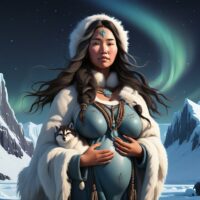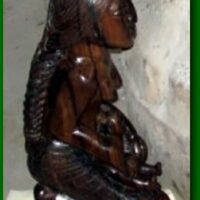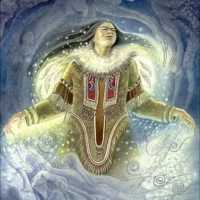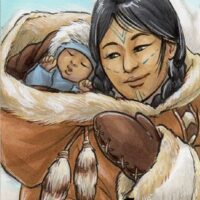Akna : Goddess of Childbirth
Listen
At a glance
| Description | |
|---|---|
| Origin | Inuit Mythology |
| Classification | Gods |
| Family Members | N/A |
| Region | Greenland, Canada |
| Associated With | Creation, Childbirth, Fertility |
Akna
Introduction
In the vast and unforgiving landscape of the Arctic, where survival hinges on resilience and the continuation of life, the Inuit people have developed a rich mythology filled with spirits and deities. Among them is Akna, the revered goddess of fertility and childbirth. Her name, meaning “mother” in Inuktitut, underscores her profound connection to the creation and nurturing of life. Akna is a pivotal figure in Inuit mythology, deeply respected for her role in fertility and motherhood. Her story is central to the Inuit’s rich tapestry of myths and legends, highlighting her importance in explaining the natural world and the continuation of life in the Arctic.
Physical Traits
Unlike deities in other mythologies with detailed descriptions, information about Akna’s physical appearance is sparse. This is likely due to Inuit spirituality’s emphasis on the function and power of spirits rather than their physical forms. However, Akna is commonly depicted as a benevolent and maternal figure. Some artistic interpretations show her with long, flowing hair, symbolizing the vastness of the Arctic night or the lifegiving rivers and streams. She might be adorned with animal furs and charms, representing her deep connection to the natural world.
In various Inuit communities, Akna is generally portrayed as a robust, nurturing figure embodying the qualities of a loving mother. She is often depicted with a warm, radiant countenance that exudes kindness and compassion. In art and sculpture, she is frequently shown cradling an infant or surrounded by children, emphasizing her role as a protector and nurturer. Her attire is usually traditional Inuit clothing, such as a parka made of animal skins, which underscores her connection to the community and the natural environment.
Family
Information on Akna’s family ties is limited due to the nature of Inuit mythology, which often focuses on spirits and powerful beings rather than traditional family structures for deities. However, some scholars suggest connections between Akna and Sedna, the goddess of the sea and sea mammals, who controls the animals that provide sustenance for the Inuit. A healthy relationship with the sea is vital for fertility and childbirth, aligning with Akna’s role.
Another aspect of Akna’s family connections is the association with spirits of newborns or unborn children, symbolizing the potential for new life she embodies. In many stories, Akna is considered the wife of Anguta, a powerful god linked to the underworld and the afterlife. Anguta is seen as a provider and a guide for souls, complementing Akna’s role as a giver of life. Together, they represent the cyclical nature of life and death, a central theme in Inuit cosmology.
Additionally, Akna is sometimes described as the mother of various deities and spirits, each influencing different aspects of Inuit life and nature. Her children include weather gods, animal spirits, and other entities that play crucial roles in daily life in the Arctic. This extensive familial network underscores the interconnectedness of all life, a core belief in Inuit culture.
Other names
Across the diverse Inuit cultures of the Arctic, Akna may be recognized by different names depending on the specific region. Variations include Angakuaq, meaning “shaman,” or simply “The Great Mother.” These names emphasize various aspects of Akna’s role beyond fertility, portraying her as a protector and guide during childbirth, akin to a shaman. In Inuit mythology, Akna is also referred to as the “mother,” symbolizing her nurturing nature and her bestowal of blessings.
Powers and Abilities
Akna’s significance extends far beyond her role in childbirth and blessings; she is revered as a spiritual guide offering wisdom and support to the Inuit people. Her influence permeates the fabric of Inuit society, strengthening bonds within families and the larger community. In the harsh Arctic environment, where survival is a constant struggle, Akna’s dominion over fertility and childbirth is paramount. Pregnant women turn to her for prayers of safe delivery, recognizing her ability to ensure the well-being of mothers and infants. Furthermore, Akna’s influence extends to hunting and fishing success, vital for sustaining life in the community.
Shamans, acting as intermediaries between the spirit world and the physical realm, invoke Akna during rituals to safeguard newborns and mothers. They also seek her blessings for abundant game and harvests, essential for survival. Akna’s powers encompass not only fertility but also healing and comfort for the sick and suffering. Her nurturing nature embodies hope and resilience in adversity. Moreover, she is believed to control the natural world, influencing seasons and weather patterns crucial for hunting and gathering.
Modern Day Influence
With the spread of Christianity in the Arctic regions, traditional Inuit beliefs faced a decline as many communities embraced Christian practices, potentially diminishing the role of Akna. However, there has been a recent resurgence of interest in Inuit culture and mythology, with artists and storytellers incorporating Akna into their work to ensure her legacy endures.
In contemporary times, Akna remains relevant for many Inuit people, symbolizing the enduring strength and resilience of their culture, as well as the perpetual cycle of life it embodies. While the ways of honoring and remembering deities like Akna may evolve with changing circumstances, her core values and ideals persist. Today, Akna continues to resonate with Inuit women, serving as a symbol of strength and resilience in raising children amidst challenging environments.
Her image is celebrated in various cultural expressions such as artwork and jewelry, reminding people of the importance of respecting the natural world, a source of life and sustenance for the Inuit. Beyond Inuit communities, Akna carries a broader message of the power and significance of motherhood, embodying the timeless cycle of life, death, and rebirth inherent in human existence.
Related Images
Frequently Asked Questions
What is lorem Ipsum?
I am text block. Click edit button to change this text. Lorem ipsum dolor sit amet, consectetur adipiscing elit. Ut elit tellus, luctus nec ullamcorper mattis, pulvinar dapibus leo.
What is lorem Ipsum?
I am text block. Click edit button to change this text. Lorem ipsum dolor sit amet, consectetur adipiscing elit. Ut elit tellus, luctus nec ullamcorper mattis, pulvinar dapibus leo.
What is lorem Ipsum?
I am text block. Click edit button to change this text. Lorem ipsum dolor sit amet, consectetur adipiscing elit. Ut elit tellus, luctus nec ullamcorper mattis, pulvinar dapibus leo.
What is lorem Ipsum?
I am text block. Click edit button to change this text. Lorem ipsum dolor sit amet, consectetur adipiscing elit. Ut elit tellus, luctus nec ullamcorper mattis, pulvinar dapibus leo.
What is lorem Ipsum?
I am text block. Click edit button to change this text. Lorem ipsum dolor sit amet, consectetur adipiscing elit. Ut elit tellus, luctus nec ullamcorper mattis, pulvinar dapibus leo.











